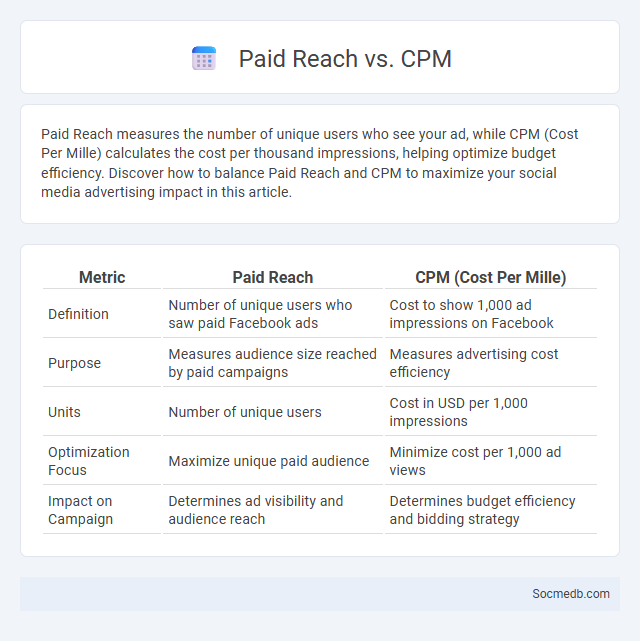
Photo illustration: Paid Reach vs CPM
Paid Reach measures the number of unique users who see your ad, while CPM (Cost Per Mille) calculates the cost per thousand impressions, helping optimize budget efficiency. Discover how to balance Paid Reach and CPM to maximize your social media advertising impact in this article.
Table of Comparison
| Metric | Paid Reach | CPM (Cost Per Mille) |
|---|---|---|
| Definition | Number of unique users who saw paid Facebook ads | Cost to show 1,000 ad impressions on Facebook |
| Purpose | Measures audience size reached by paid campaigns | Measures advertising cost efficiency |
| Units | Number of unique users | Cost in USD per 1,000 impressions |
| Optimization Focus | Maximize unique paid audience | Minimize cost per 1,000 ad views |
| Impact on Campaign | Determines ad visibility and audience reach | Determines budget efficiency and bidding strategy |
Introduction to Paid Reach and CPM
Paid reach on social media refers to the number of users who see your content as a result of paid promotions or advertisements, extending beyond organic visibility. Cost Per Mille (CPM) measures the cost to deliver 1,000 impressions, serving as a key metric to evaluate the efficiency of your paid campaigns. Understanding how CPM and paid reach interact helps you optimize your budget to maximize exposure and engagement for your social media marketing efforts.
What is Paid Reach?
Paid reach on social media refers to the number of unique users who see your content as a direct result of paid promotions or advertisements. This metric is crucial for measuring the effectiveness of sponsored campaigns across platforms like Facebook, Instagram, and Twitter. Tracking paid reach helps businesses optimize their ad spend by targeting specific audiences to increase brand visibility and engagement.
Understanding CPM (Cost Per Mille)
CPM (Cost Per Mille) represents the advertising cost per one thousand impressions on social media platforms like Facebook, Instagram, and Twitter. Advertisers analyze CPM to measure the efficiency of their campaigns and optimize spending based on audience reach and engagement rates. A lower CPM often indicates better targeting and higher potential return on investment for digital marketing efforts.
Key Differences: Paid Reach vs CPM
Paid reach measures the exact number of unique users who see a sponsored social media post, providing direct insight into audience exposure, while CPM (Cost Per Mille) calculates the cost of 1,000 ad impressions, focusing on budgeting and ad efficiency. Paid reach prioritizes actual user engagement potential, whereas CPM enables marketers to optimize spending across campaigns by comparing cost effectiveness. Understanding both metrics is essential for balancing audience reach goals with advertising budget constraints on platforms like Facebook, Instagram, and Twitter.
Advantages of Focusing on Paid Reach
Focusing on paid reach in social media campaigns enables precise targeting of specific demographics, increasing the efficiency of ad spend and boosting conversion rates. Paid reach provides measurable metrics such as click-through rates, impressions, and return on ad spend, allowing marketers to optimize strategies based on data-driven insights. This approach ensures consistent visibility on platforms like Facebook, Instagram, and LinkedIn, overcoming organic reach limitations caused by algorithm changes.
Benefits of Optimizing for CPM
Optimizing for CPM (Cost Per Mille) on social media significantly enhances ad campaign efficiency by maximizing impressions within targeted demographics, thereby increasing brand visibility and engagement rates. This approach allows advertisers to control budgets effectively while improving ROI through better audience segmentation and precise bidding strategies. Leveraging CPM optimization tools offered by platforms like Facebook and Instagram ensures campaigns reach the right users at optimal times, amplifying overall marketing impact.
How to Measure Paid Reach Effectively
Measuring paid reach effectively involves tracking metrics such as impressions, unique users reached, and click-through rates across platforms like Facebook Ads Manager and Google Ads. Utilize conversion tracking pixels and UTM parameters to connect ad exposure to specific user actions, providing a clear return on investment (ROI). Implementing A/B testing on ad creatives and targeting ensures accurate assessment of paid reach efficiency and audience engagement.
Budget Allocation: Paid Reach vs CPM
Effective budget allocation in social media marketing involves balancing paid reach and cost per mille (CPM) to maximize campaign efficiency. Investing in paid reach targets specific audiences directly, increasing engagement and conversion rates, while optimizing CPM ensures broader exposure at a lower cost per thousand impressions. Marketers analyzing platform data such as Facebook Ads Manager and Google Ads can strategically shift budgets to maintain an ideal mix that aligns with campaign objectives and ROI goals.
Real-World Campaign Examples
Nike's "Dream Crazy" campaign featuring Colin Kaepernick generated over 6.5 million engagements across Twitter and Instagram, amplifying the brand's commitment to social justice. Starbucks' #RedCupContest leveraged user-generated content to boost holiday season sales by 7%, demonstrating effective community engagement. Airbnb's "Live There" campaign utilized localized social media ads to increase bookings by 25% in targeted urban markets.
Choosing the Right Metric for Your Goals
Selecting the right social media metrics depends on your specific goals, such as engagement, brand awareness, or conversions. Metrics like click-through rates (CTR) are crucial for measuring campaign effectiveness, while follower growth gauges brand reach. Analyzing these targeted metrics ensures data-driven decisions that optimize social media strategy and ROI.
 socmedb.com
socmedb.com